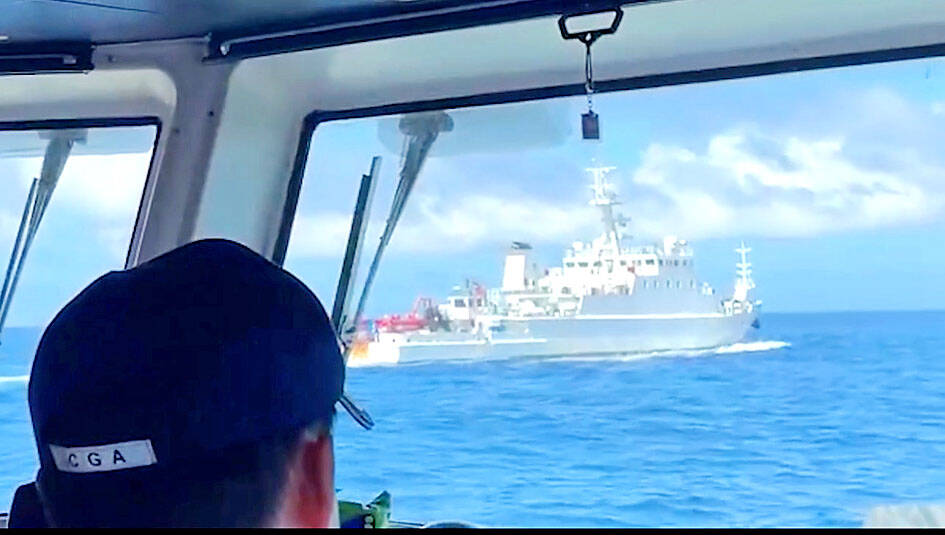The Coast Guard Administration (CGA) personnel yesterday expelled two Chinese research vessels from waters north of Taiwan, the CGA said in a news release.
The two vessels — the Xiang Yang Hong 18 (向陽紅18) and the Dong Fang Hong 3 (東方紅3) — were detected in waters north of Taiwan at 9:58am, sailing southeast and northeast respectively, it said.
The CGA said it dispatched patrol vessels to shadow and monitor the Chinese boats in a two-to-one formation, driving them out of Taiwan’s waters.

Photo courtesy of the Coast Guard Administration
The research boats were detected 58 nautical miles (107km) northwest of Pengjia Islet (彭佳嶼), with the Xiang Yang Hong 18 heading in the direction of Taiwan proper, it said.
At 12:16pm, the CGA broadcast a warning 7.8 nautical miles west of Pengjia Islet and forced the vessel away using maneuvering techniques, it said.
Radio communication with the Xiang Yang Hong 18 confirmed that it had changed course to depart. At 3:45pm, the vessel was 25 nautical miles east of Pengjia Islet, leaving Taiwan’s waters, it said, adding that one CGA vessel continued to monitor the boat.
At 12:35pm, the Dong Fang Hong 3 was 42 nautical miles north-northwest of Cape Fugui (富貴角) (14 nautical miles outside the restricted waters), sailing northeast. The CGA vessels shadowed the boat along the boundary of Taiwan’s waters. At 4pm, it was 40 nautical miles north-northwest of Pengjia Islet, and the CGA personnel continued to monitor it to ensure it did not change course toward Taiwan’s waters, it said.
“The Chinese research vessels have blatantly ignored international maritime regulations by intruding into Taiwan’s waters,” the CGA said. “We called on China to cease such actions that undermine regional peace and stability. Such actions only stir resentment among people on both sides of the Taiwan Strait.”
The CGA would continue to uphold maritime law and would closely monitor the activities of Chinese vessels approaching or entering Taiwan’s waters, it said.
In other news, a recent report by three Control Yuan members on four incidents from June last year to May in which small Chinese vessels entered Taiwan’s waters in the north — one of which involved a Chinese boat entering the Tamsui River estuary undetected — said that the incidents showed a critical failure of defenses.
The report, by Control Yuan members Lai Ting-ming (賴鼎銘), Yeh Yi-chin (葉宜津), and Hsiao Tzu-yu (蕭自佑), said the mouth of the Tamsui River is only about 8km from Guandu Bridge and 22km from Taiwan’s political and economic hub.
The Ministry of National Defense has long regarded the area as a key location where the People’s Liberation Army could enter Taiwan to carry out a decapitation strike, it said.
Given this vulnerability, the estuary should be heavily fortified, but a Chinese boat — 7m long, 1.97m wide, weighing 1.8 tonnes, and traveling at 18 knots (33km) — was able to easily sail all the way to Tamsui Pier 2, underscoring a serious weakness in defenses, it said.
The report recommended that the CGA conduct a thorough review of personnel training and equipment procurement.
It also said that the CGA Special Task Unit should conduct unannounced penetration tests on CGA units to improve vigilance and readiness in monitoring and surveillance.
Additional reporting by Lo Tien-pin

Trips for more than 100,000 international and domestic air travelers could be disrupted as China launches a military exercise around Taiwan today, Taiwan’s Civil Aviation Administration (CAA) said yesterday. The exercise could affect nearly 900 flights scheduled to enter the Taipei Flight Information Region (FIR) during the exercise window, it added. A notice issued by the Chinese Civil Aviation Administration showed there would be seven temporary zones around the Taiwan Strait which would be used for live-fire exercises, lasting from 8am to 6pm today. All aircraft are prohibited from entering during exercise, it says. Taipei FIR has 14 international air routes and

Taiwan lacks effective and cost-efficient armaments to intercept rockets, making the planned “T-Dome” interception system necessary, two experts said on Tuesday. The concerns were raised after China’s military fired two waves of rockets during live-fire drills around Taiwan on Tuesday, part of two-day exercises code-named “Justice Mission 2025.” The first wave involved 17 rockets launched at 9am from Pingtan in China’s Fujian Province, according to Lieutenant General Hsieh Jih-sheng (謝日升) of the Office of the Deputy Chief of the General Staff for Intelligence at the Ministry of National Defense. Those rockets landed 70 nautical miles (129.6km) northeast of Keelung without flying over Taiwan,

City buses in Taipei and New Taipei City, as well as the Taipei MRT, would on Saturday begin accepting QR code payments from five electronic payment providers, the Taipei Department of Transportation said yesterday. The new option would allow passengers to use the “transportation QR code” feature from EasyWallet, iPass Money, iCash Pay, Jkopay or PXPay Plus. Passengers should open their preferred electronic payment app, select the “transportation code” — not the regular payment code — unlock it, and scan the code at ticket readers or gates, General Planning Division Director-General Liu Kuo-chu (劉國著) said. People should move through the

The Ministry of National Defense (MND) today released images of the military tracking China’s People's Liberation Army (PLA) movements during the latest round of Chinese drills around Taiwan. The PLA began "Justice Mission 2025" drills today, carrying out live-fire drills, simulated strikes on land and maritime targets, and exercises to blockade the nation's main ports. The exercises are to continue tomorrow, with the PLA announcing sea and air space restrictions for five zones around Taiwan for 10 hours starting from 8:30am. The ministry today released images showing a Chinese J-16 fighter jet tracked by a F-16V Block 20 jet and the